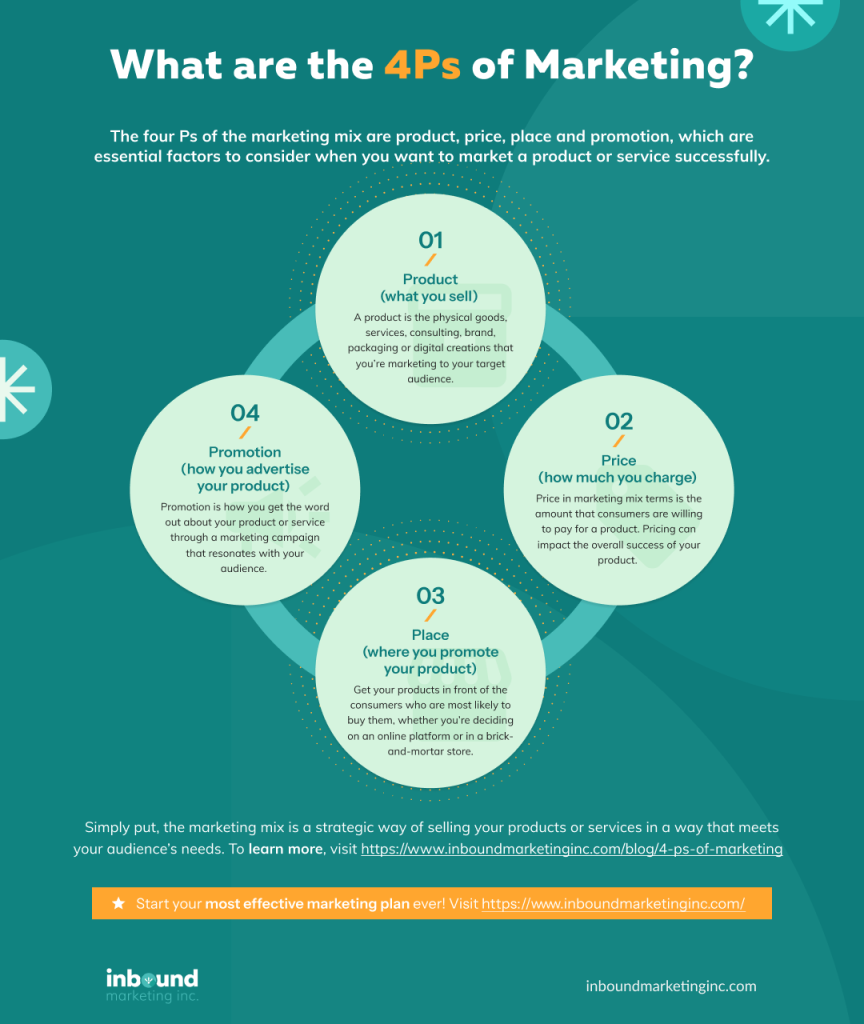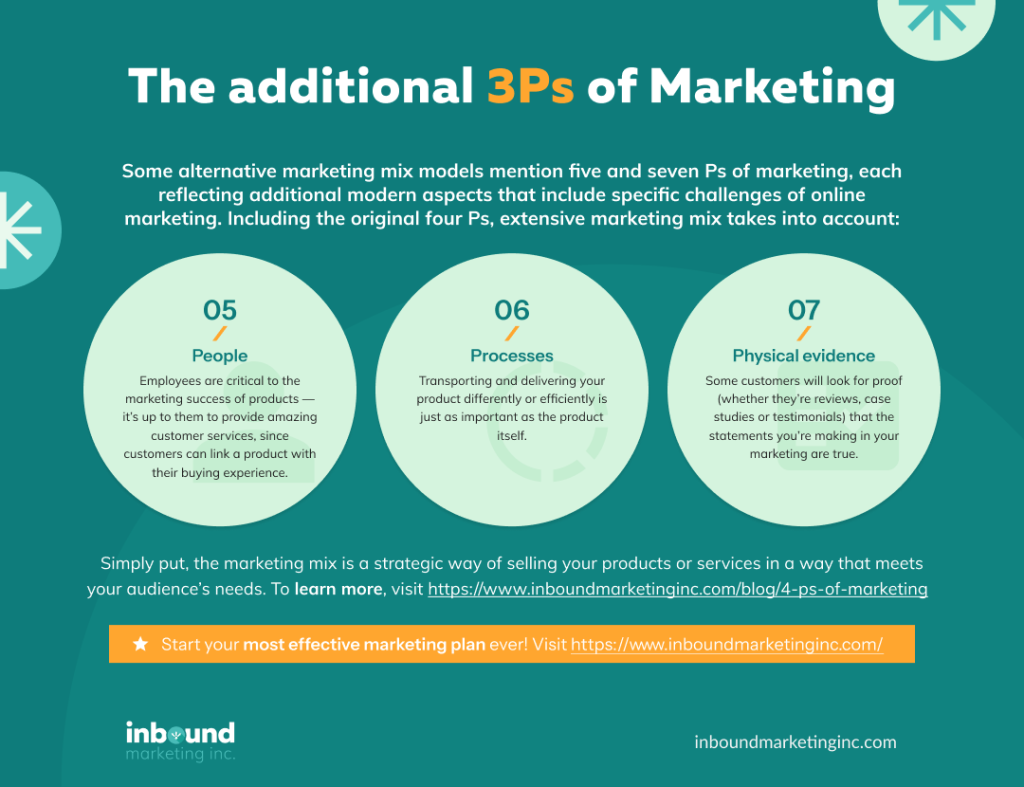The four Ps of marketing, often referred to as the marketing mix, can be used to help your business develop and execute marketing strategies. The four Ps of this marketing mix are product, price, place and promotion, which are essential factors to consider when you want to market a product or service successfully.
Download the full 4 P’s of Marketing infographic
Neil Borden, an advertising professor at Harvard, came up with the idea of the marketing mix and the concept of the four Ps in the 1950s. Since then, others have developed and refined these ideas and even added components to the marketing mix. However, the four Ps remain the most common.
What is a marketing mix?
The marketing mix is a combination of elements one needs to keep in mind when creating a marketing strategy. Although the four Ps of marketing are the main components, many other factors add to the building blocks marketers use to create a successful marketing campaign.
Simply put, the marketing mix is a strategic way of selling your products or services in a way that meets your audience’s needs. When done right, a marketing mix can:
- Give you a competitive edge
- Help with informed decision-making
- Create value
- Identify strengths and areas of improvement
- Help create a winning pitch
It is not meant to be static, though. It needs adjustment and refinement as your product grows or your target market changes.
The 4 Ps of marketing (with examples)
Let’s have a more detailed look at the four basic pillars of a typical marketing strategy.
- Product (what you sell)
A product is the physical goods, services, consulting, brand, packaging or digital creations that you’re marketing to your target audience. A successful product satisfies a need in the marketplace, solves a problem or provides an innovative customer experience that creates demand.
Put yourself in your customers’ shoes to understand what your product can offer.
- What is the product?
- What does your product do or accomplish?
- Does your product fulfill a need or provide a unique experience?
- Who is your product’s ideal customer?
- How is your product different from other offers?
Who got it right? Everyone knows about Coca-Cola, the everyday common soda beverage that people can enjoy on its own, with meals or with get-togethers.
Oops! Samsung has launched many amazing products in the past, but the Samsung Galaxy Note 7 took “getting fired up” to a whole new (unfortunate) level.
- Price (how much you charge)
Price in marketing mix terms is the amount that consumers are willing to pay for a product. Pricing can impact the overall success of your product. If it’s too high for your target audience, very few will purchase it. On the other hand, if it’s too low, people will perceive it to be of low quality or quality and pass it up.
Both scenarios can cut into your profit margins, so consider the right price by answering the questions below.
- How much do your competitors charge for similar products?
- How much is your target audience willing to spend?
- What is the highest price you can sell your product for? And lowest?
- What price best fits your target market?
- How much does it cost to create your product?
Who got it right? Because Amazon buys items directly from manufacturers, they’re able to sell them at a reasonable price that the average person can afford.
Oops! American Airlines went through a financial rough patch in the 1980s and, in an attempt to raise capital quickly, introduced AAirpass — an unlimited first-class product as either a five-year or lifetime pass for a flat rate.
- Place (where you promote your product)
Like price, finding the right place to market and sell your product is essential to make your customers happy. The goal is to get your products in front of the consumers who are most likely to buy them, whether you’re deciding on an online platform or in a brick-and-mortar store.
There are a couple of things to consider while researching the best place to market and sell your products.
- Where will you sell your product?
- Where do your ideal customers normally shop?
- What distribution channels are best to reach your target market?
- Where is the competition selling its products?
- Which places or venues do buyers frequent for similar products and services?
Who got it right? Customers have a variety of ways to buy Apple products, including physical stores, their website and authorized resellers.
Oops! Burger King ran a campaign on smart devices that read a list of burger ingredients from Wikipedia — a great marketing idea, until hackers changed the Wikipedia post to include dangerous ingredients.
- Promotion (how you advertise your product)
Promotion is how you get the word out about your product or service through a marketing campaign that resonates with your audience. Several digital channels can help your promotion efforts via email, social media and content marketing. And let’s not forget the traditional methods that include print ads, TV commercials and word of mouth.
While working on your promotion, it’s important to consider these questions.
- When is the best time to reach your audience?
- What channels are most effective or preferable for customers?
- What advertising approaches will persuade your audience most?
- Which marketing methods are most cost-effective to promote your product?
- Where are your competitors spending their marketing revenue?
Who got it right? DoorDash uses a mix of traditional and online marketing methods to spread the word, including TV ads, social media, print and partnering with restaurants and fast-food chains.
Oops! In one of Airbnb’s email campaigns, they used an image of a house on the surface of the water with the subhead “stay above water”, which wouldn’t have been bad if not sent amidst the chaos caused by Hurricane Harvey in Houston.
Are there more than 4 Ps in a marketing mix?
Some alternative marketing mix models mention five and seven Ps of marketing, each reflecting additional modern aspects that include specific challenges of online marketing. Including the original four Ps, extensive marketing mix takes into account:
Download the full 4 P’s of Marketing infographic
- People: Employees are critical to the marketing success of products — it’s up to them to provide amazing customer services, since customers can link a product with their buying experience.
- Processes: Transporting and delivering your product differently or efficiently is just as important as the product itself.
- Physical evidence: Some customers will look for proof (whether they’re reviews, case studies or testimonials) that the statements you’re making in your marketing are true.
Apply the 4 Ps of marketing with Inbound Marketing Inc.
Still unsure if your marketing mix is meeting the needs of your target market? Inbound Marketing Inc. can get you everything you need for your digital marketing campaigns, strategies and specialists included! With our customizable digital marketing services, we’ll consider all the Ps to create a marketing mix that will help you achieve your business goals.
Ready to outperform your competition and streamline your marketing with a full-service digital agency? Contact us online to receive a free quote or give us a call at 888-675-9886.

